Watergate East: The Early Days
Recalled by George E. Arnstein - (January 20, 2003, with minor edits on July 25, 2009)
This first in the series was penned by George Arnstein, who moved into Watergate East on November 24, 1965 — and who continues to be one of our most active members in this 50th year.
In the process of cleaning out old files, I found a receipt for two keys to the front door of our apartment, dated November 24, 1965. This agrees with my recollection that we — my late wife, Sherry, and I — moved in over Thanksgiving. Ediltecno S.p.A was identified as authorized agent for the owner which also operated as Watergate Improvement Associates.
The sponsor used an Italian architect, Luigi Moretti, plus an affiliated domestic firm [SOM] but the Italian ties were visible to the point where the enterprise was known as Vatican City West, reflecting the minority interest of the Vatican. And I certainly recall how Joe (Giuseppe) Cecchi, a leading light of the undertaking, was among the very early residents at the South end of the second floor.
We had been invited to move by early November, but my wife wisely suggested that we ought to wait a month because the building looked unfinished. Unfinished it was: while the structure was complete, the top floors were not finished; the hallways and lobby were uninviting. Just before our move-in we were invited for a walk-through. (Another item from my notes: The original drapes were ROVANA, made by Dow Chemical, nonflammable, rot and mildew resistant; dry clean. I just found them in my basement locker which I am also purging.)
We noted several deficiencies, and I then asked to see our parking space. The awkward reply was that the sponsor did not yet have an occupancy permit for the garage, that they would provide valet parking, and — very important — that we would have first choice of any spot we wanted, other than a dozen reserved for the expensive penthouses. And that is how it came to pass that I own an unusually wide space, because my wife wanted easy access and exit, and we often used it to accommodate a second [compact] car. The very first summer, the son of a neighbor, home from college, parked his MG there. The neighbors, Mortimer and Mickey Janis became friends and I am still in touch with Mickey, now a widow living in a retirement community in Potomac. To this day I sometimes get invited to the Kennedy Center, with the tacit acknowledgment of a parking space.
Rental, not Coop
We were a rental during the first few months, mostly because a cooperative, by law had to have x percent owners. We did reach that magic number. So on March 28,1966 the sponsor issued the call for the first annual meeting to be held April 18, 1966 at 8 pm in the auditorium of the Peoples Life Insurance Building (today the Saudi embassy.)
The sponsor had many names. This specific memo was signed by Harold Lewis, as President of Riverview Realty Cooperation. The attached "Notice" was signed by Joseph Lewis, identified as Secretary of Watergate East Inc. The report of the president of Watergate East Inc. was signed by Royce Ward who, in fact, worked for the sponsor. Quite properly he reported: "on March 29th the formal transfer of title between Watergate Improvement Associate and Watergate East will be accomplished....The documents will be bound, and a complete set made available to Watergate East for their permanent use." I can't help but note that Ward, being "our" president, also said
"The public areas [i.e.lobbies etc.] should be completed in the near future. The fountains should soon be in operation again. The swimming pool will be ready in time for the season." "Air cond. May 1" presumably discussed at the meeting.
The initial Board of Directors was hand picked [who else would or could?] by the sponsor, succeeded by duly elected members which included Mary Garner, elected secretary, who lived here until her death in 2008. I was elected and reelected as a director in 1971 and served as treasurer. My second stint was in 1994, again reelected. Today I serve on one committee.
What will soon (2009) be a fire control room off the South lobby, initially and temporarily was a package room as well as a place to leave and pick up dry cleaning. Our lobbies were not completed and could not handle these items. The first issue of our in-house newsletter, The Watergate Post, was dated May 6, 1966 and noted,
"There are by now well over 100 families.... Approximately 20 more families take occupancy each week... the Builder has not been able to handle problems in occupied apartments as promptly as he, we or you would like."
Backups on entering the garage were frequent because the "toll booth" for the commercial garage was located almost at street level. Result: we, the residents, had to wait while outsiders fumbled for money or directions. There was no neon sign to show whether the commercial space was full with similar results, something we still encounter occasionally when drivers don't believe in signs. As for the cab stand, original plans called for the installation of a call light, but the plans were mislaid, to be revived months later, after our request.
There had been management memos like the one issued February 26, 1966. It forecast a liquor store by late April, Valet for May, Riggs Bank (now PNC) in May, People's Drugs (now CVS) in June, Safeway late July, Pastry shop in June, and a "restaurant for the latter part of year." My notes show that the barber shop opened Summer of 1966, and the Safeway on October 5, 1966.
Strangely enough, I cannot recall where the restaurant was or was to be located, since the hotel was built much later. We used to have an unobstructed view up river, clear to Key Bridge. Fortunately the sponsor had clearly disclosed that we were Stage 1, to be followed by others — South (with a confusing name since we have our own South wing), originally intended as all apartments, the Office building and hotel, and West. Even today, many city maps show South as a solid horseshoe despite the split into an office and an apartment building.
"We are ...negotiating leases for several ... stores, including travel agency, jeweler, florist, savings and loan, haberdashery and ladies apparel." Indeed the jeweler, the S&L and the haberdasher came and went, as did Colette, a ladies boutique. Many a weekend I explored our building, the unfinished top floors, and the nearly ready storage areas and the promised shopping.
This is a good place to recall the rather precious [in my opinion] advertising campaign of the sponsor, the Italian company that had the vision to make something of a site which had been the gas works, more or less at the edge of the city. I recall how the AAUW moved its headquarters on Farragut Square to their own newly built home on Virginia Avenue (the corner where Western Presbyterian now stands). I thought it was far from my job, then at 16th & M.
Watergate was advertised as a sophisticated, expensive (because they emphasized the penthouses), elegant place to live, so much so that one resident urged that our desk clerks were to wear tails. She obviously did not prevail.
The reality was less sophisticated. The disputes between our Board and the sponsor reached a point where an early president of the cooperative said: "They seem to have forgotten that they no longer own it; we do." There was a roof that leaked and was fixed at major expense to the sponsor, but only after a serious threat of litigation by a resident, Tommy the Cork [Thomas Corcoran] who was a senior partner in a leading law firm. After many a rainstorm, dirt poured from the adjacent empty lot (now Watergate South) into our garage. A picture of the lot hangs in the North B3 elevator lobby.
The August 8, 1969 Life magazine had an illustrated feature story which included Watergate West. The heading sets the tone:"In Washington it used to be Georgetown, now it's Watergate." It enumerated, confined to Nixon's GOP,
three Cabinet members, two senators, Nixon's chief of protocol and more than a dozen White House aides."
Some Personal Items:
Disappointed in the sink in our guest bathroom, we approached the sponsor in writing, that the display in the sales office had shown something much nicer. After a delay they fixed it.
We thought the trash chutes too noisy, met with some resistance, then got them insulated. The "proof" was that a neighbor, also awakened by a heavy load, at 2 a.m. got up to investigate — only to encounter me, headed for the trash room on the same mission. We prevailed. After all, we had been promised good sound proofing (which continues to be quite good to this day.)
Ventilation in the kitchen was poor. At first we were told that DC Code prohibited a hood over the stove. I found a memo of February 1, 1967 in which "the sponsor determined that the ventilation... is not up to the standards set by the sponsor ...decided to install a hood...at no cost to you."
There is more, but this gives the flavor.
I like the architecture, although I also recall at least two jokes:
The lower denture.
The Kennedy Center is the box in which the Watergate came.
I guess the anachronistic jibe was aimed at the Kennedy Center, which came after us, and so did our Foggy Bottom Metro station. The Howard Johnson Motel (now a GWU dorm) preceded us, reportedly owned at the time by persons living in our Cooperative.
The VP Caper
When LBJ was President, Hubert Humphrey was VP, and there was no VP mansion. Watergate was new and prestigious, so the day came when HHH and his wife, Muriel, checked out Watergate East. The Secret Service, we learned, would "capture" an elevator for exclusive use (and protection) of the dignitary as he came and went. Our Board decided that this would inconvenience our residents and things came to naught. HHH moved into Harbor Square in SW Washington where there were separate elevators to serve various banks of apartments.
Adverse decisions by the Membership Committee and the Board were very rare, handled discreetly. There were mere rumors that a pop star was turned down because his music would be too intrusive.
Electronic Progress
We always had telephone answering service, but this was before voice mail. Desk clerks answered the phone and placed a message into individual mail boxes, then turned on the message light. We did have a master antenna on the roof, including a special connection for FM radio and for TV. Vestiges are still visible in most apartments. The wall outlets were for TV, with another link for FM (which fell into disrepair within recent memory).
Our garage used to have free access. The gate, monitor, and electronic keys were installed later. One personal example comes to mind. My wife called me (there was then only a phone at the door) because she could not start the car. Explanation: somebody had stolen the battery.
Sidelights on the Watergate Terrace Restaurant
Because there had been the well known Watergate Restaurant, located where the Kennedy Center is now, "our" restaurant had to modify its name. Later it struck a deal with our Board for us to give up the open terrace, essentially unused, which overlooked our pool. The restaurant people expanded their space, glassed in the terrace (which had merely been part of the scenery from the meeting rooms) and repaired the roof. As part of the swap they promised to plant annually the beds or planters which face our pool, and to maintain the marquee at our pool, but that part of the deal seems forgotten.
This essay deals with the early days, before the infamous break-in when our building became a historic landmark. We were deemed more photogenic than the office building, thus appeared nightly on TV news. Or the evening I returned from a late afternoon swim and my wife asked who else was there. My reply: "A small crowd. I think I was the only one not under indictment."
One of those, I could name the cabinet member, showed at the pool his quite interesting "home" movies of his African safari. This was part of a short series of movies shown for several years in an improvised setup at the pool, one of the few times the open terrace was used.
Before I conclude, I want to mention Alice deAngelo, an early resident who became a widow, retired from her job with the Navy, and became an essential part of management. For example, she was Assistant Secretary who prepared the minutes. She was the keeper of the files and was the kind of living memory from whom we benefitted until she had to move for health reasons. A picture and details can be found at watergatenotes.net
Similarly a good word for Kerry Stowell, former president, and a prime mover behind the 25-year history of Watergate East, published in 1992, long out of print.*
Finally, the impetus for this highly personal account is Carmen Neuberger, who mentioned that we ought to have another history, and that I should not throw out my files.
*This booklet is available electronically. If interested, send and email and please include your name, contact information, and the reason for your request.
=====================^back to top^
Under Siege
The infamous 1972 break-in and the following political scandal that made "gate" an international suffix for scandals — large and small — was not the first time the Watergate and its residents were under siege. In 1972 and 1998, the siege was reporters. In 1970, it was students!
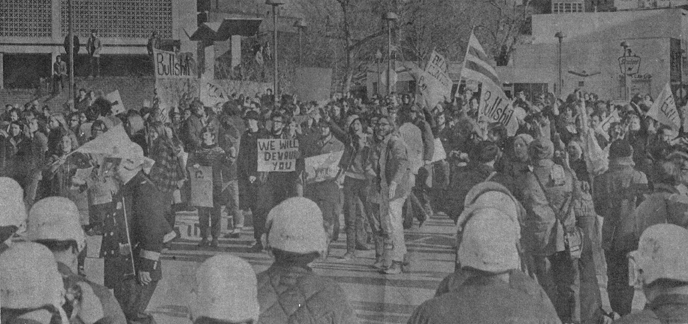
Watergate was the site of a major student protest in 1970. In the weeks prior to the jury verdict in the Chicago Seven trial (held in Chicago), political activists began planning and advertising a "People's Tour of Watergate" to occur at the Watergate East home of then United States Attorney General John N. Mitchell.
The verdict was handed down on February 18, 1970. Five of the defendants were found guilty of incitement to riot (all were found not guilty of conspiracy).
That night, more than 200 people rallied at D.C.'s All Souls Unitarian Church to prepare for the next day's mass protest — a leaderless demonstration scheduled to fall on TDA — "The Day After".
On February 19, several hundred protestors gathered on Virginia Avenue in front of Watergate East hoping to enter the building. They were met by a wall of several hundred police bused in to prevent the demonstration. The police engaged in street fighting with protestors, forcing them to retreat toward the Howard Johnson's and back onto the George Washington University campus. The People's Tour of Watergate fizzled. The campus was not so fortunate, as the battle moved to two GWU dorms. Tear gas was used to disperse the crowds. More than 145 were arrested, including bystanders, faculty and students and one GWU police officer unexpectedly caught in the melee.
Although a second protest was expected the following day, it never emerged and police spent the day drinking coffee and eating cookies and pastries baked at the Watergate East's pastry shop.
The story and aftermath were reported in the February 20, 1970 GWU Hatchet.
=====================^back to top^
Forty-three Years Since (June 17, 2015)
The infamous June 17, 1972 break-in and the following political scandal that made "gate" a suffix for scandals large and small all over the world was not the first time the complex and its residents made headlines. Tantalizing as it is to report on earlier notorious events, we offer instead a "write a Watergate limerick" challenge. Here are those contributed by various Watergators.
-----------------------------------------
Twas forty-three years ago this date,
From water to bridge to deflate,
The suffix was set,
It is a sure bet
That scandals will end in a gate.
-----------------------------------------
Fifty years to date
Here at Watergate
Events continue to reverberate.
Making history is our fate
Giving us reason to celebrate.
-----------------------------------------
There once was a President Nixon
Who thought democrats needed fixin',
So he said with a sardonic grin,
As he stroked his 5 o'clock chin,
How about an undetectable break in.
-----------------------------------------
A break-in was nothing to fear
And shouldn't have produced even a tear
Our address is more than historical
So don't be hysterical
Have I made myself perfectly clear?
-----------------------------------------
=====================^back to top^
Higgins Fueling Station
Higgins Service Station stands at the southeast corner of the intersection of Virginia Avenue NW and Rock Creek and Potomac Parkway. Built in 1932, it was designed in the domestic style* to complement the parkway - blending into the natural setting (filling stations were the only commercial building type allowed on parkways). It is one of the few remaining rustic commercial structures in Washington, DC.
L. P. Higgins was the original proprietor, selling the station to the Haynes family in the 1940s. It changed ownership again in 1970 and a few years ago. In 1935, a photo shows a large sign on the roof that read "Higgins Service Station," removed long ago. The garage bays were extended about 4 feet in the 1950s.
The station was built with a functioning basement, which was later filled in to meet evolving building code restrictions on fueling station layout. Security bars were added in the mid-1970s.
The station is built of local stone. Two non-functioning chimneys decorate the rear slope middle of the building. Inside, a wood stairway leads to an unfinished attic. The clock over the main door aided in continuity of design differentiating a commercial establishment from a residential one.
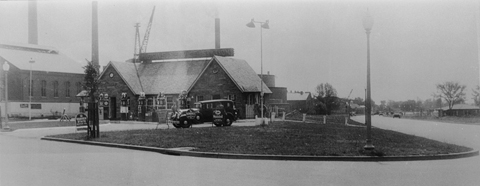
Higgins Fuel Station, c.1932 - This image is a work of an employee of the United States Farm Security Administration or Office of War Information domestic photographic units, taken as part of that person's official duties.
=====================^back to top^
Waiter Service at the Pool? Yes!
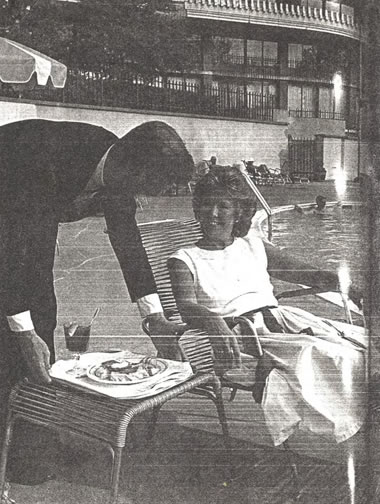
Washingtonian Magazine, 1983
One of the long-lost, but often discussed, amenities was the waiter service at the Watergate East pool, as shown in the above photo. After extensive sleuthing, we verified, in real time, the existence of a poolside snack bar (the Wine Barrel), making this service available to pool users. Read on....
After Building One (the working name the design/construction team gave to Watergate East) was finished and the second phase of Watergate was being built (Office Building and Hotel), a group of restaurateurs (Restaurant Corporation of America, Inc. [RCA]) was introduced to William Graff, project architect for the Watergate project. They needed an architect for the design of the Watergate Terrace space (the main hotel dining room) that they were renting from the hotel.
Their names were Harald Giesinger (Austrian), Guido Gerosa (Swiss) and Albert Uster (Swiss). These three also rented a space in the retail mall for a "Watergate Pastry Shop", also designed by Mr. Graff, with the counter* having the shape of Building One. RCA enjoyed immediate great success, especially with the pastry shop.
By 2001, when Harald Giesinger died, the restaurant had been sold. Mr. Uster opened an import business - mostly items from Switzerland - but died tragically in an airplane accident. Mr. Gerosa moved to Florida, continuing his successes in the restaurant business until his death in 2004.
By 1970, Mr. Giesinger was chair of the board and chief operating officer of RCA. In that same year, Mr. Giesinger was involved in a minor legal matter. The legal documents described the areas leased and/or managed by RCA.
"On April 18, 1966, RCA leased certain commercial space from Watergate Improvement Associates within the development known as Watergate.
"The Watergate project is located in an area bounded by Virginia Avenue, New Hampshire Avenue, F Street, and the Potomac River Parkway, N.W., in the District of Columbia. Within this complex are located three apartment buildings, two office buildings, a hotel as well as shops and restaurants. Watergate was designed as a single project and was approved by the Board of Zoning Adjustments as a planned unit development. Each of the edifices within the Watergate project is physically connected on the lower three levels, B-1, B-2, and B-3, which are devoted to parking and shops. There are no public streets or roads within the Watergate project, but automobiles can drive between each of the buildings by virtue of the interconnecting underground levels.
"Watergate was constructed in four phases, beginning in 1965. The primary structure constructed in phase one was the Watergate East Apartment Building. The following areas were leased by RCA in Watergate East:
(1) On level B-1, a portion of the Watergate Terrace where the main restaurant and related facilities were constructed. A substantial portion of the Watergate Terrace is adjacent to and underneath the Watergate Hotel which was constructed as a part of phase two.
(2) The pastry shop located on level B-2.
(3) On level B-2 the mall cafe and its small accompanying kitchen.
(4) On level B-2 the poolside snack bar (Wine Barrel) with a small kitchen, lounge, and dining room.
"All of these areas were fully operational during the year in issue (1970). In addition to the exclusive right to operate restaurants and cocktail lounges in the Watergate project, RCA was obligated to "provide catering services and room service for the entire Watergate project." The hotel guests and owners of all of the cooperative apartments within the Watergate project could sign checks as though the restaurant were an adjunct to the hotel and apartments. RCA engaged waiters assigned solely to room service, and printed menus for room service were placed in each hotel room. There were approximately 140 employees of RCA during the fiscal year ending August 28, 1970."
On August 26, 1973, the owner of the Watergate Hotel acquired RCA.
=====================^back to top^
A Taste of Watergate
In season, the pool becomes the center of social life, much as it has since 1966. Lap swimmers work out before the sun is too high. Children and parents or caretakers arrive in the late afternoon. A six-year old talks with a ninety-two year old discovering their mutual interest in not only swimming but in other sports and in animals. They exchange first names, some generational etiquette, and are off to a fast friendship. Pre-teenagers arrive from camp to play pingpong with corporate executives home early on a summer afternoon — or just someone else's parent.
Age and rank meld seamlessly.
Dozens of newsworthy individuals live here now and previously. Maintaining one's privacy is simple and respected. One long time resident writes, "we find out more about our neighbors by reading the papers and watching the news than we do by passing each other in the hall or living next door." Yet the opportunity to meet the neighbors occurs daily in the elevator, at the laundry room, at the formal get togethers hosted by the building management and board of directors or at impromptu roof top parties. While privacy is respected, a few stories about the more famous may be warranted, and hopefully always enjoyed. Political spying aside (we assume you all know that a bungled burglary and break-in at the Democratic National Committee headquarters brought down a president), did you know the CIA's unofficial historian and decorated member of that organization lived here?
Our taste of Watergate includes a cookbook, a cake, and a French chef and one of his recipes.
Who's in the Soup?
In Washington, a lot of us go out to eat -- to be seen and to be in the scene. It is exciting to dine with the more well-known in our town. When we do cook, it is for our friends and family -- and to get a bit of what we all know we crave: privacy. The 50th anniversary cookboook, a community cookbook, opens the door to a glimpse of Watergate and Washington entertainers that might go undiscovered otherwise.
Community cookbooks were so much more than just a catalog of recipes — they were fundraisers, political pamphlets, and historical accounts of the communities they served. With community cookbooks, one gets an insight into history that isn't there from any other source, it's not in newspapers, it just hasn't survived. And that historical value, might be more important to modern cookbook buyers than any recipe inside. So what began as practical household how-to guides, are now more likely to be a coffee table conversation starter than a reference in the kitchen. Such a one was "The Watergate Cookbook" featuring Martha's Sweet and Sour Tongue, McCord's Spilled Beans, and Ellsberg's Leek Soup.
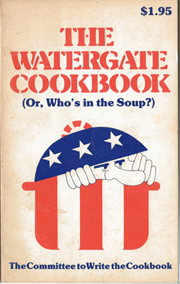
A Cyclorama and a Thirteen Story Cake
Connecticut Avenue based Riverview Realty Corporation was selected as the sales and leasing firm for "the luxurious new $66 million Watergate apartment, hotel and office complex" in 1963. After the 1964 ground breaking, Riverview moved its offices to the Virginia Avenue property, just west of the Building One construction site. To show prospective purchasers the views from balconies and windows not yet in existence, they built a cyclorama, a circular photographic panorama hanging over a scale model of the complex.
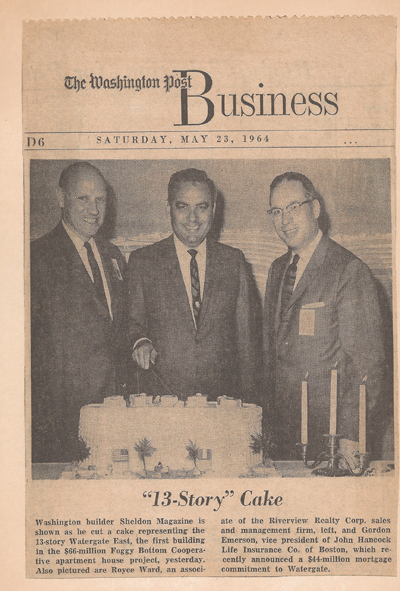
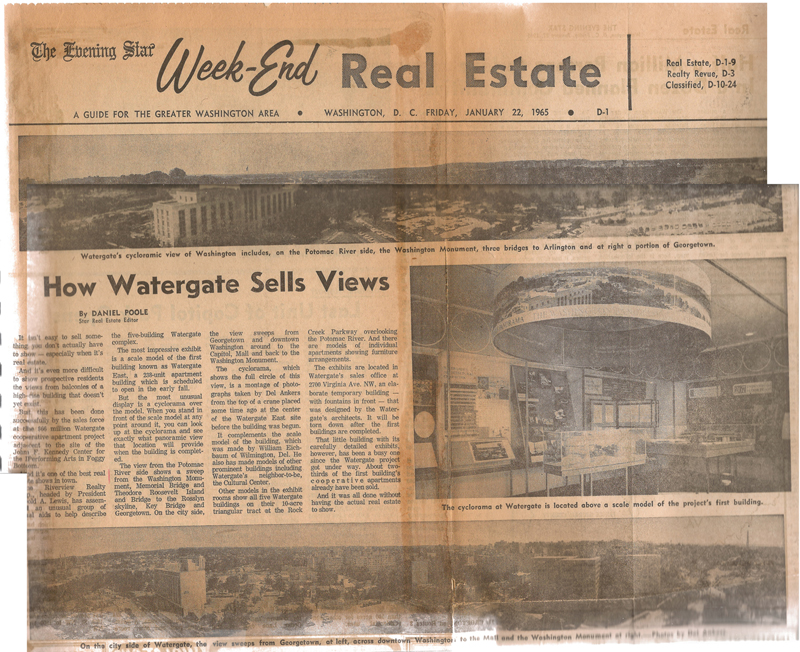
Jean-Louis at the Watergate
Jean-Louis Palladin was not just a chef, but also a gardener. His restaurant, Jean-Louis at the Watergate, way down in the sub-basement of the Watergate Hotel — in the space briefly occupied by the National Capitol Democratic Club — was a special place with only a handful of tables. Opened in 1979, the draped orange silk wall panels, hung with mirrors, and tables dressed with Limoge china create a divine atmosphere, where no expense was spared — either by the chef or by the diners he delighted with his exceptional nouvelle cuisine. A diner commented, "the fish and meats are superb, but the desserts take the cake." The vegetables were enhanced with fresh picked herbs from the chef's Watergate garden. Some of us escape the humid Washington summers by taking off to Maine. With that in mind, here is a favorite Jean-Louis recipe. Be sure to get Maine shrimp!
Deviled Eggs with Shrimp and Radishes
The shrimp add a briny sweetness to the egg filling. If you can find fresh small Maine shrimp, use them whole.
12 large eggs
1 tablespoon pure olive oil
2/3 pound small Maine shrimp* (if you cannot get Maine shrimp, substitute medium shrimp, shelled and deveined)
Salt and freshly ground pepper
1/2 cup mayonnaise
1/4 cup finely diced red radishes (about 4 large)
2 tablespoons minced parsley
2 teaspoons capers, chopped
1 medium shallot, minced
1 garlic clove, minced
1. Put the eggs in a large saucepan and cover with cold water. Bring to a boil over moderate heat, then simmer the eggs over low heat for 10 minutes; drain. Transfer the eggs to a large bowl of ice water to chill thoroughly, then peel. Cut the eggs in half lengthwise. Put the yolks in a bowl and mash lightly with a fork. Set the whites on a platter.
2. Heat the olive oil in a large skillet. Add the shrimp, season with salt and pepper and cook over moderately high heat, stirring, until opaque, about 3 minutes. (If you are using regular shrimp, transfer the shrimp to a work surface and cut 12 of them in half lengthwise. Cut the remaining shrimp into 1/3-inch dice.)
3. Add the Maine shrimp, left whole, to the egg yolks. Add the mayonnaise, radishes, parsley, capers, shallot and garlic, season with salt and pepper and stir to blend. Mound a rounded tablespoon of the filling in each egg-white half and top with a shrimp half. Serve at room temperature or chilled.
MAKE AHEAD
The filling and cooked egg whites can be refrigerated overnight. Stuff the eggs just before serving.
SUGGESTED PAIRING
The crispness and pleasing citrusy notes of an Alsace Riesling play up the sweetness of the shrimp in the deviled eggs.
*Maine shrimp are in season from January to April.
